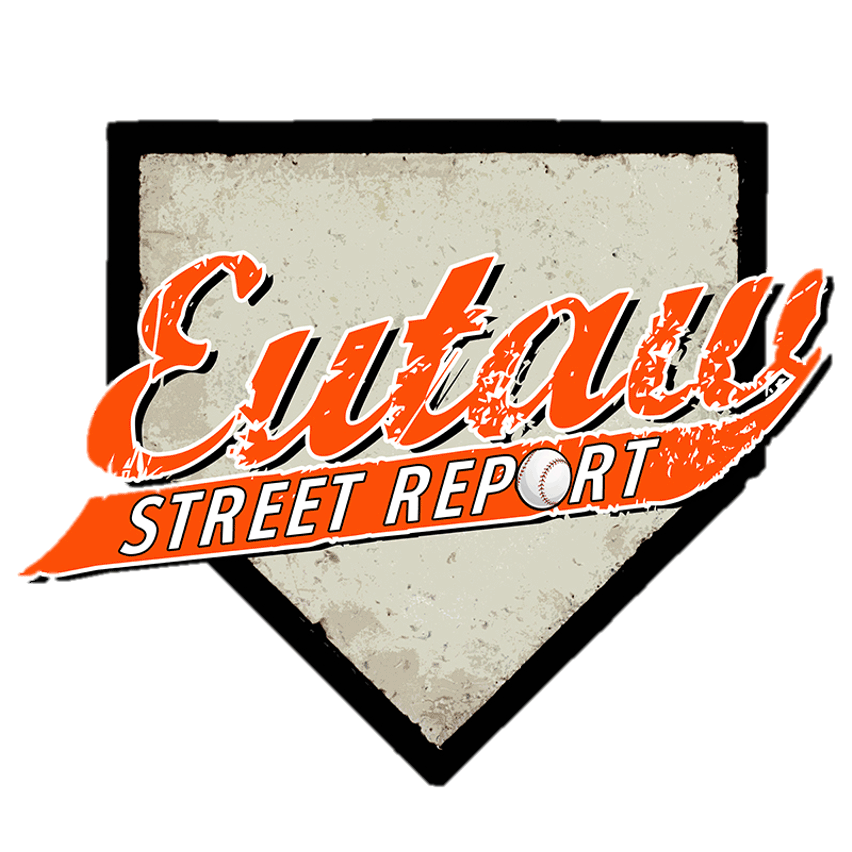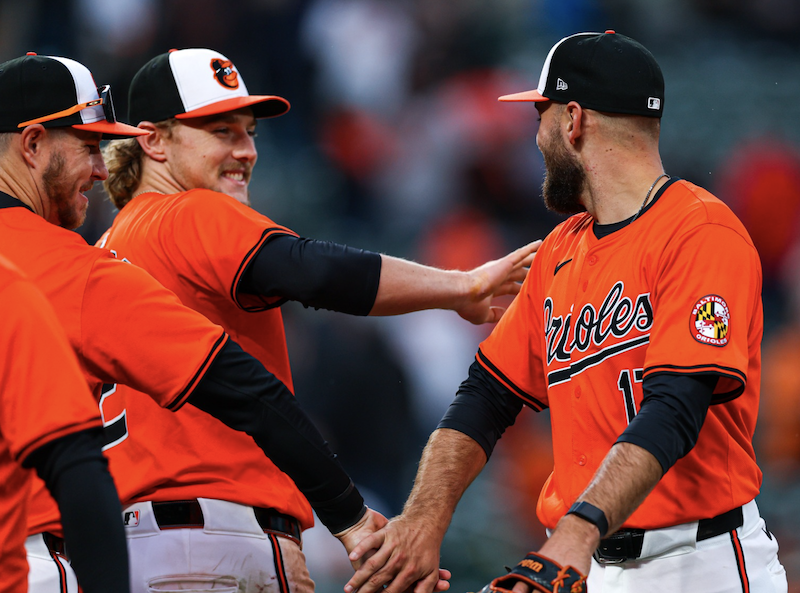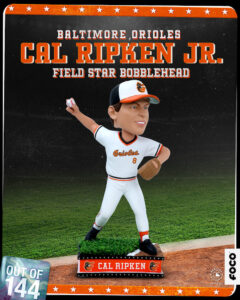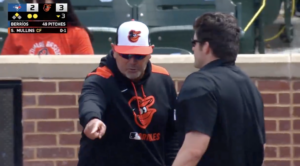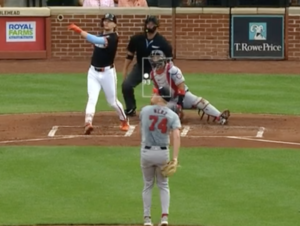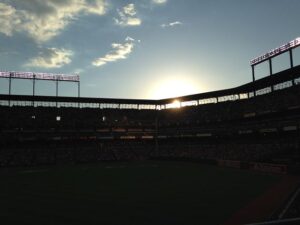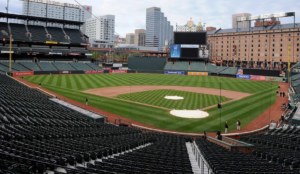Spring Training has started, baseball is back and the usual cliches are running rampant already. There is a lot of excitement around this O’s team so far. It has been a lot of good vibes, players in shape, Samuel Basallo’s daily batting practice show and really no bad injury news, a far cry from a season ago on that front.
That said, there is always off the field stuff happening and a consistent such discussion amongst O’s fans is about contract extensions. Whether it’s Adley Rutschman or Gunnar Henderson or whomever, the fans crave these contracts. But really, how smart are these extensions? And how eager should a team be to sign them?
Earlier in this offseason, the Oakland A’s extended Brent Rooker. That leaves the Orioles as the ONLY team in MLB not to have a player on their roster that has been extended. There are a lot of reasons to be upset by that yes, but it’s also understandable.
The Orioles are in a unique position around the league. While most teams may have a few extension-worthy players, the Orioles roster is loaded with them with potentially more to come. The Atlanta Braves were in that same situation a few years ago and they extended a large group of players.
This is the type of thing O’s fans want to see, so let’s look at those contract extensions.
First, let’s get the no-brainer deals out of the way. Despite his injuries, the Ronald Acuña contract is one of the biggest steals in MLB history. We don’t really need to spend time discussing this one. Atlanta has him signed for several years (including club options) and he is drastically underpaid compared to market rates.
The other no-brainer is Ozzie Albies. He signed a 7/$35M deal when he had five years of service time left. The Braves are only paying him $16M total for those five years and then he has two FA seasons and two club option seasons at $7M per season. While his production has been a little up and down and he has had a few injuries, this contract is a steal. Backup players are getting $7M a year and this is a bona fide All-Star level player who has had multiple 3+ WAR seasons already. His 2023 season was almost worth as much as this entire contract.
If you can sign any player to deals this cheap, clearly you do it.
There were five other deals signed by Braves, two of which were pre-arbitration deals. The first one is Austin Riley. Riley signed a 10-year, $212M contract two years before hitting free agency. The deal paid him $15M and $21M in the final two years of arbitration and then extended his stay with Atlanta for eight years at $176M. He gets paid $22M a year for the next seven years and $20M in the final year. Had Atlanta not signed him, he would have entered this offseason as a FA at age 28. He would have done that coming off his worst season since 2019. While he was still worth just under 3 fWAR, he saw a big decline and his defense is trending the wrong way. Would he have been able to get 8/176 this offseason? I say maybe, but I don’t think it’s definite. I am not saying he can’t be a 4+ WAR player again. Players have down years and bounce back on a regular basis. That said, how much longer can he stay at third base? Does his size hinder him long term? If he must move to first or DH, his overall value will go down. This contract isn’t a bust by any means but right now, it also doesn’t look like a slam dunk.
The Braves traded for Matt Olson and a day later signed him to an eight-year $168M deal. Like Riley, they paid him $15M and $21M for his final two arbitration seasons, making his extension six years at $132M. Again, like Riley, the average annual value (AAV) isn’t terribly high, especially considering how much salaries have increased over the last five years. That said, Olson is about to turn 31 and is also coming off his worst season in several years. Again, this doesn’t mean he can’t bounce back but at age 31, you do wonder if he would have been able to get a 6/132 deal this offseason as a free agent. Pete Alonso, who is far inferior defensively, is coming off a 2.1 fWAR season (Olson was 2.6) and only managed to get a 2/54 contract. I think it’s highly doubtful to think Olson gets 6/132. I think he gets more than Alonso got but falls short of $132M.
Atlanta’s final arbitration extension was for Sean Murphy, as they signed him to a six-year, $73M deal with three years remaining until free agency. Murphy received $28M for his three arbitration years, so he received a 3/45M extension, eating up those first three free agent years. He has been in Atlanta for two seasons, so this is his final arbitration season and then the three FA years. He is 30 years old and is coming off a 0.8 fWAR season. While I don’t think the Braves would have non-tendered him entering this offseason, it would have been a consideration. This is a big drop from where he had been but it’s not unusual to see catchers drop off as they cross age 30. That said, are the Braves happy to have him for $15M a year from 2026-2028? I’m guessing, if they could, they’d take a mulligan on this contract.
The final two deals are, like Acuña and Albies, pre-arb deals. Michael Harris, coming off his NL ROY season, signed an eight-year $72M deal. He had five years left of team control, so it’s really a three-year extension. This contract has a unique structure in that he is making $5M for his second and third pre-arb seasons (players normally get $1M or less for these years) and has a high arb1 price tag at $8M. However, his second arbitration season is also $8M and his third one is $9M. Overall, those five years are at $35M, which is likely less than he would have made, but not certainly much less. The three-year extension is 3/32. He is still very young and is a centerfielder, so he will likely be worth this deal. As the contract is for little money overall and he will be in his 20s for the duration, this is a good gamble for Atlanta.
The last deal is Spencer Strider‘s. He signed a six-year $75M deal. The Braves received one guaranteed FA year and they also have a club option for his second FA year. This deal was largely to keep his arbitration numbers at a certain level and get thos two FA years, each of which are for $22M – a steal if he’s healthy and performing. This will be an interesting one to watch. He already missed one of those six years, as he had Tommy John surgery last season. He likely doesn’t start the year in the rotation and likely will be held back some as the season goes on. It is fair to ask: was this a smart deal by the Braves? They are guaranteeing him $75M and only gain one or two years out of it.
Would the Braves like to take back several of these deals? Maybe. They may not care because the AAVs aren’t that bad for any of them. That being said, they likely could have signed Riley and/or Olson for less money, and they likely wouldn’t keep Murphy beyond this year if he continues to struggle.
So, maybe they like the players but having fewer years and less money committed to them would be preferable.
And that is really the crux with these deals. If things go right, the teams can save a lot of money and they gain some extra years. That is great. However, in many of these deals, the Braves had these guys for five more years anyway. So, you are putting out a lot of money for just a few years. Sure, the contracts like Acuña and Albies are no-brainers. They are so cheap, that you have to do it. We have to consider, though, that those are two Latin players, typically the guys you see signing the cheaper contracts. That type of player likely didn’t receive a big signing bonus, and there’s a good chance they grew up in poverty, so getting these huge contracts, even if they are considered bargains for the team, are so completely life-changing for them and their families, that they can’t say no.
Now, that’s not usually the case for the American players. For teams, is it worth guaranteeing all this money, when you have the players under team control for most of the deal anyway?
Orioles fans are screaming for these deals but I am not on board.
Let’s say you could sign Colton Cowser to the Harris deal. In terms of performance after year one, they are similar. However, Cowser is three years older. Do you want to lock him up well into his 30s? If it’s cheap enough, maybe, but Cowser is a guy whose game partially relies on his speed and athleticism. That tends to get worse with age, especially at over 30 (the O’s already have him locked up until he is 30). So, why would you sign him? Just to say it got done?
What about Grayson Rodriguez? Would you give him the Strider deal? On paper, it looks OK, and the Orioles are not likely to ever non-tender GRod, so the salaries aren’t likely to be much different. But what if Rodriguez continues to have injury issues? What if he has to have some sort of surgery? Then it no longer becomes a slam dunk deal.
From a comment @fangraphs. I know it's at least directionally correct, but can anyone verify specifics?
Regardless, it's a sober reminder that Rubes can't just open his checkbook and make these guys O's for life. Until we read one of them fired Boras… pic.twitter.com/bnagMs6H9H
— Eutaw Street Report (@EutawStReport) February 19, 2025
As for Henderson, we do not know if he wants to sign an extension or if Scott Boras has talked him out of it. If he does sign, it will be to a contract similar to Bobby Witt Jr.‘s but for more money. Witt is guaranteed to be with KC for six more seasons at about $110M. If the O’s could get Gunnar to sign for six more years (that is the four years they already have him, including 2025, and two FA years), they likely would have to pay $120-130M. They could structure it like Witt’s deal with an opt out every year but instead of $30-35M per year in FA, you probably have to be $40-45M.
That said, this is not a team-friendly deal. When teams sign these extensions, they do so to keep the player longer and to save some money if things go right. The deal outlined above would not save the team money, and they would only get two extra years. So, you are essentially guaranteeing him $120-130M for two seasons. That calls into question the validity of the contract.
Now, that being said, I would like to see Henderson sign it. Those extra two years mean something in that the O’s aren’t potentially looking to trade him entering his final arbitration season, knowing he is planning to test the FA market. (Like the Brewers did with Corbin Burnes last year).
For me, the Orioles only have four extension candidates (at most) right now. Gunnar and Jackson Holliday are the two no-brainers for me. The problem is, Boras talks his clients out of pre-arb deals (see Tweet above).
That does not mean you can’t get it done. As I just showed with Gunnar, perhaps if you do it while still paying all the money (ie, no bargain prices), the O’s can get the deal done as they are basically guaranteeing Henderson as much money as he could likely get in a best-case scenario for that time period.
Remember how I mentioned Latin players taking the life-changing money? That doesn’t apply to Henderson, and certainly not to Holliday. What’s the player’s incentive to sign early?
Now, a player who does fall into that category is Samuel Basallo. I think they Orioles should be looking into extending Basallo very soon for this reason.
Finally, there’s Rutschman.
I go back and forth on him, but I think he represents a different case than simple player output when it comes to a team’s benefit on an extension. That being said, I am not sure if he signs the deal I’d like the O’s to offer him.
Baltimore has him for just two more years after 2025. Let’s assume he is likely to make something around $25M, give or take, in those two seasons. He just turned 27, so he is here until 29. How many years beyond that do the Birds want to guarantee a catcher on the wrong side of 30? I would certainly offer him a four-year deal for around $75M (2 FA years at $25 per), and would likely go to five (six would be less ideal, but would depend on the total dollar value).
Would Adley sign any of those offers? I am skeptical.
As for everyone else, they’re just too risky for my tastes. Jordan Westburg, like Cowser, is an older player who you would be extending into his 30’s. Kyle Bradish you have for several more years and is now coming off Tommy John surgery. A contract for him also takes him well into his 30s. Heston Kjerstad is still too unknown and is also older. Coby Mayo is a potential candidate, but we need to see more from him and see how he transitions to first. He has some of that Austin Riley potential in him as he gets older because of his size. Maybe Felix Bautista, but he’s a big guy who has already had one major surgery. He is a risk but perhaps one worth taking once this season is over.
Right now, no matter how much fans want these deals done, there are a lot of reasons not to do them. While I get that, as a fan, we are always happy to keep our favorite players around, there is a business aspect to this that can’t be ignored. These are very questionable deals for the team unless they are getting the player to sign dirt cheap contracts. I think you are going to see fewer and fewer of those type deals, especially for American players.
